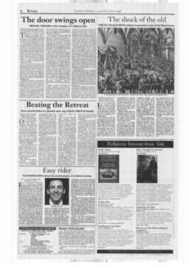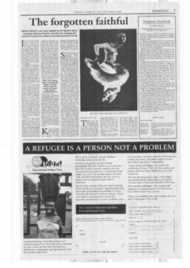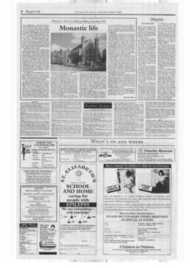Page 8, 29th November 1996
Page 8

Report an error
Noticed an error on this page?If you've noticed an error in this article please click here to report it.
Tags
Share
Related articles
Ealing Abbey
Monastic Historian, Prior Of Ely And Biographer
Tlith.. Reconstruction Of :
The Life Of An Abbey
Abbey Welcomes Retreatants
Monastic life
PARISH IN Focus: Ealing Abbey, London W6 I AM USHERED into a room that belongs in Victorian England. Dom Vincent Cooper's study, at the top of the stairs, is a gentleman's retreat from the trials of the day. Books and wall hangings, kilims and paintings, mementoes of far-flung places cram the small space. He is on the 'phone; I take in an eclectic taste Tennyson, Marvell and Yeats, Japanese scrolls, Indian lanterns, pebbles and pottery. It is a comforting, fascinating room.
He smiles: "It's full of things that other people have thrown out the print of Montmartre came from the jumble sale. This is my family corner." He hands me a Victorian, sepia-tinted print of a family stiffly posed for the camera. "I hail from Scotland, it's good to be reminded of one's roots".
We set off on a tour of the parish centre. Aggie Crisp, parish secretary, is introduced as the "linchpin of the place, indispensable, indispensable". There are five monks on the parish team, one secular priest and a married former Anglican priest who joined the parish this year. In conjunction with spiritual and secular services, Ealing Abbey supports a Benedictine study centre run by Dom James Leaclunan and runs a comprehensive counselling service unique for a Catholic parish in England. Seventy counsellors work here with over 300 clients. `We ask people to make a contribution, but more funds ate needed. We need more room and would like to pay for more supervisors."
Lack of space in the parish centre has led to the adoption of a 'hot desks' policy. The priests with the exception of parish priest Dom Cooper have given up their individual offices. "I live in palatial isolated splendour," he confides. "Everyone else is sharing!"
It was Cardinal Vaughan who invited Downside Abbey to open a house in London from which the monks would travel to sing the Offices in the new Westminster Cathedral. "They were located in Ealing 'Queen of the Suburbs' for easy access to Victoria," says Dom Coopc.r. Cardinal Vaughan's idea never materialised but the Benedictine presence in West London had been established. The church opened in 1899 and in 1902 St Benediet's school was founded. As the parish grew, the church was extended; the rank of Abbey
was granted to Ealing by the Papal Brief `Londinii in Urbe' received in 1955.
In 1940, the Abbey was bombed and a large section destroyed. The church was partially restored in the 1960s but remained incomplete. "Our motto is: 'Build a church for God and God will build a congregation to worship in it'. The Benedictines put down foundations here to build a tower. It won't be my generation that sees it built maybe some time in the future but we are raising funds to restore and complete the Abbey as it was originally intended". The Centenary Appeal will finance refurbishment and restoration works and the building of a new choir area and self contained chapel.
Music and the singing of the Offices are central to the life of the monastery. The
acoustics of the church are wonderful. Dom Cooper launches into the Kyrie his voice echoing to the high candy-striped rafters. How would he describe the architecture of the church? "Twelth century Norfolk that's what it reminds me of". I know what he means, this lovely building belongs in the countryside there's something about the simplicity of the interior with its muted tones, ochre walls and high clear windows. "When I was in India the people spoke of buildings being soaked in prayer. This church is the same. We do pray here".
Morning sunlight reflects the tracery of gothic arches against a far wall. Gold embroidered cloth swathes the altar. It is truly beautiful. To the side a modem chapel with mosaic fresco of St Boniface stands in contrast to
the soft and faded colours of the church. It was paid for by the German government in 1962, in reparation for the war damage. A bronze panel recalls two parishioners killed in the Zeebrugge ferry disaster. Their parents still worship here.
Statues and icons grace quiet alcoves and turnings. Stephen Nemethy, "our local artist", has created golden Eastern images that inspire. Our Lady Queen of Heaven is a copy of the statue at Downside. St Jude is here too though he has been stolen several times. A plaster saint is standing in as they await a carved wooden replacement. "We had so many brass candlesticks we used to spend all day Saturday polishing them; there's not a single one left. If someone steals something he must need it; that's what my mother used to say". The church is open from 6am until after Compline at night. "There's nothing left to steal now; a church should be open".
There is history and tradition here but overwhelmingly a sense of the future. Dom Cooper shows me the extension site. The monks are still looking forward. "We build on the work of people who have gone before us," he says. By way of explanation he shows me the Abbey graveyard simple wooden crosses, hidden behind a high hedging of holly and laurel. Newly-laid turf patches the frozen ground: "We decided to give the fathers a new coat," says Dom Cooper, recalling names and characters that have helped shape both parish and community.
We walk the expanse of the garden to the pond. The ground is frozen, the grass covered with a thin coating of ice that cracks like sugar frosting underfoot. Dom Bartholomew was previously head gardener at Knebworth and has brought his horticultural talents to this quiet, secluded place. We are looking for Britannia, pride of the Monastery. Dom Cooper spies her, a golden carp slipping silently through the water.
"I came to London to join the Jesuits but changed my mind," he says. "People knock on my door and I have my feet up! I decided I needed other people, to be part of a family, that prompts you to pray."
Christina White
blog comments powered by Disqus











